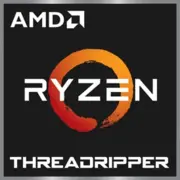AMD Ryzen Threadripper 1950X

AMD Ryzen Threadripper 1950X: A Guide to the Legendary 16-Core Processor in 2025
Introduction
Even years after its release, the AMD Ryzen Threadripper 1950X remains an iconic processor for enthusiasts. Released in 2017, it became a symbol of the revolution in multi-core CPUs. In 2025, it can be found on the secondary market for $300–400, and it’s still relevant for specific tasks. Let’s explore who should consider this model today and for what purposes.
1. Key Specifications: Architecture and Performance
Zen Architecture and 14nm Process
The Threadripper 1950X is built on the Zen microarchitecture (first generation) using GlobalFoundries’ 14nm process. It was AMD's first processor with 16 cores and 32 threads, a breakthrough in 2017. Key features include:
- 32 MB L3 Cache — to accelerate rendering and calculations.
- SMT Support (Simultaneous Multithreading) — effective task distribution.
- Quad-Channel Memory Controller — bandwidth of up to 85.3 GB/s.
Performance
- Geekbench 6: 1175 (Single-Core), 7483 (Multi-Core).
- In multi-threaded tasks (e.g., rendering in Blender), it still outperforms modern budget 8-core CPUs such as the Ryzen 7 7700X.
- Practical Example: Rendering a 3D scene in Cinema 4D takes ~8 minutes, whereas the Intel Core i5-13400F (10 cores) takes ~12 minutes.
Key Features
- Unlocked Multiplier — overclocking capability (up to 4.0–4.2 GHz with good cooling).
- 64 PCIe 3.0 Lanes — support for multiple GPUs and NVMe drives.
2. Compatible Motherboards: Sockets and Chipsets
Socket TR4 (SP3r2)
The Threadripper 1950X uses a unique TR4 socket with 4094 contacts. As of 2025, new motherboards for it are not being released, but models using the X399 chipset are available on the secondary market:
- ASUS ROG Zenith Extreme — a top-tier motherboard with Wi-Fi, 8 SATA slots, and RGB lighting ($250–350 used).
- MSI X399 Gaming Pro Carbon AC — a good balance of price and functionality ($180–250 used).
Selection Features
- VRM Cooling — due to its TDP of 180W, it is critical to select a motherboard with substantial heatsinks.
- PCIe Configuration — 64 lanes allow for the connection of 3–4 graphics cards or several NVMe disks.
3. Supported Memory: DDR4 and Its Potential
The Threadripper 1950X works exclusively with DDR4. Recommendations include:
- Frequency: Optimum is 2933–3200 MHz (officially supports up to 2666 MHz).
- Quad-Channel Mode — use 4 or 8 modules for maximum speed.
- Configuration Example: 4×16 GB DDR4-3200 (64 GB) — ideal for 8K video editing.
4. Power Supplies: Power Calculation
With a TDP of 180W and the appetites of modern graphics cards:
- Minimum: 650W (for RTX 4070 or RX 7700 XT).
- Recommended: 750–850W (if planning to overclock or install RTX 4080/4090).
- Certifications: 80 Plus Gold or Platinum (e.g., Corsair RM850x, EVGA SuperNOVA 750 G6).
5. Pros and Cons of the Threadripper 1950X in 2025
Pros
- Price/Performance — At $300 for 16 cores, it offers better value than new Ryzen 9 processors.
- Multi-Core Power — suitable for rendering, virtualization, and scientific calculations.
- Flexibility of Configuration — supports 4 GPUs and 2TB of RAM (theoretically).
Cons
- Outdated Platform — lacks PCIe 4.0/5.0, DDR5, USB4.
- High Power Consumption — 180W compared to 105W for Ryzen 9 7900X.
- Upgrade Complexity — transitioning to new Threadripper models requires a motherboard change.
6. Use Cases: Where the 1950X is Still Relevant
Work Tasks
- 3D Rendering (Blender, Maya) — 16 cores outperform newer 8-core models.
- Virtualization — run multiple operating systems simultaneously without lag.
- Video Encoding — HandBrake utilizes all 32 threads.
Gaming
- Streaming — CPU encoding + gaming on GPU in one PC.
- 4K Gaming — if not limited by single-core performance (delivers 60–70 FPS in Cyberpunk 2077 with RTX 4080).
7. Comparison with Competitors
Intel Core i9-10980XE (18 cores, 2019)
- Pros: PCIe 3.0 x44, higher IPC.
- Cons: More expensive ($400–500 used), worse multi-core performance.
AMD Ryzen 9 5950X (16 cores, 2020)
- Pros: 7nm, PCIe 4.0, DDR4-3200.
- Cons: No quad-channel memory, more expensive ($450–500 used).
8. Practical Assembly Tips
Cooling
- Coolers: Noctua NH-U14S TR4-SP3 or AIO Cooler Master MasterLiquid ML360.
- Thermal Paste — make sure to update (Thermal Grizzly Kryonaut).
Optimization
- Overclocking: Set frequency to 3.9–4.0 GHz at 1.35V.
- Memory: Activate the XMP profile for DDR4-3200.
9. Final Conclusion: Who Should Consider the Threadripper 1950X?
You should choose this processor if:
- You are a professional on a budget — rendering, editing, calculations.
- You need to upgrade an old workstation without a complete platform swap.
- You have hobby tasks — home server, virtualization experiments.
However, if you are a gamer or need PCIe 5.0/DDR5 — look towards Ryzen 7000 or Intel 13th Gen.
Conclusion
The Threadripper 1950X is an example of a “long-lived” processor. It may not be perfect, but it remains a cost-effective choice for specific tasks even in 2025. The key is to select the right motherboard, memory, and power supply to unlock the full potential of this legendary 16-core processor.
Basic
CPU Specifications
Memory Specifications
GPU Specifications
Miscellaneous
Benchmarks
Compared to Other CPU
Share in social media
Or Link To Us
<a href="https://cputronic.com/cpu/amd-ryzen-threadripper-1950x" target="_blank">AMD Ryzen Threadripper 1950X</a>